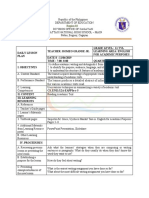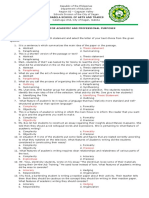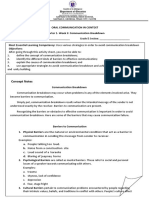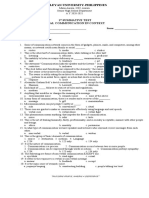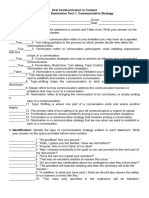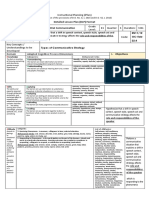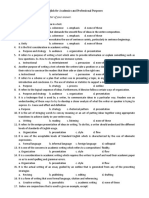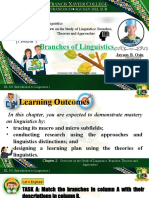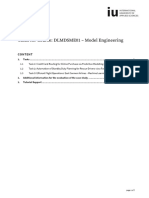3RD Periodical Exam Oral Communication
3RD Periodical Exam Oral Communication
Uploaded by
rufino delacruzCopyright:
Available Formats
3RD Periodical Exam Oral Communication
3RD Periodical Exam Oral Communication
Uploaded by
rufino delacruzOriginal Title
Copyright
Available Formats
Share this document
Did you find this document useful?
Is this content inappropriate?
Copyright:
Available Formats
3RD Periodical Exam Oral Communication
3RD Periodical Exam Oral Communication
Uploaded by
rufino delacruzCopyright:
Available Formats
DEPARTMENT OF EDUCATION
Bayambang National High School
Bayambang, Pangasinan
Table of Specifications in
Oral Communication
(Third Periodical Test)
Item Placement under
each Cognitive Domain
Number Number Easy (60%) Average Difficult
Learning Competencies of hours
%
of Items (30%) (10%)
Remembering Applying Evaluatin
& & g&
Understanding Analyzin Creating
g
1. Define communication 0.5 4 2 1,44
2. Explain the nature and process of 31,32,33,34,
communication 3 24 12 35,36,37,38, 43,45
39,40
3.Differentiate the various models of
communication
1 8 4 6,7,19, 42
4.Explain why there is a breakdown of
communication
0.5 4 2 20, 5
5.Use various strategies in order to avoid
communication 1 8 4 46,47 13,14
breakdown
6. Demonstrate sensitivity to the socio-cultural
dimension
of communication breakdown: Culture, 2 16 8 23,25,48 28,16 2,3,12
Gender, Age,
Social Status and religion
7.Discuss functions of communication 1 8 4 17, 49, 18 11
8. Identify the speaker’s purpose 1.5 12 6 22,29,30,50 15 4
9. Ascertain verbal and nonverbal cues that
10,21,24,26,
each speaker to convey his/her ideas 2 16 8 8,9,41,
effectively 27
12.5 100 50 items
Total: hours % 30 15 5
Prepared by:
JOSEPH E. MALONGGA
SST II, HUMSS I-A
Noted by:
ELVIRA P. BERDUL
SSHT VI/OIC, Office of ASP II
Approved by:
MARY ANN J. PAYOMO, Ph.D
PRINCIPAL IV
Noted:
CANDRA E. PENOLIAR, D.A.
PSDS
DEPARTMENT OF EDUCATION
REGION 1
Schools Division Office 1 Pangasinan
BAYAMBANG NATIONAL HIGH SCHOOL
SENIOR HIGH SCHOOL
Bayambang, Pangasinan
THIRD PERIODICAL EXAM
Oral Communication
NAME: ______________________ YEAR and SECTION:______ HPS:______ SCORE:_____
I. MULTIPLE CHOICE
Direction: Choose the correct answer from the options given in every item. Write the letter of your
choice in your answer sheet
1. Which best applies the definition of Oral Communication?
a. a teacher giving advice to a problematic student
b. a man promising material wealth to win the heart of a woman
c. an enemy orally destroying the reputation of his enemy
d. none of the above
2. Which of the following justifies the true essence of facilitating a speech class?
a. Recorded conversations are advisable teaching materials.
b. Variations of sound should be seen by students.
c. Production of sounds should be taught first.
d. All of the above
3. What evidence that shows the correct definition of communication?
a. Communication is a process.
b. Communication occurs between two or more people
c. Communication can be expressed through written or oral.
d. All of the above
4. There is a variety of context and situations in which communication can be manifested. Which is not included?
a. a face to face interaction c. a phone conversation
b. a group discussion d. a gig in a farm
5. Which model applies the use of communication as a linear process?
a. Shcramm Model c. Shannon-weaver model
b. Transaction Model d. Inventive model
6. Shannon-weaver Model has been criticized for missing one essential element in communication process. What is it?
a. speaker b. message c. channel d. feedback
7. Which model involves the commonality of field of experience in doing the communication process?
a. Shcramm Model c. Shannon-weaver model
b. Transaction Model d. Aristotle’s model
8. It refers to an interaction in which words are used to relay a message
a. verbal communication b. nonverbal communication c. jargon d. noise
9. It refers to an interaction where behaviour used to convey and represent meanings.
a. verbal communication b. nonverbal communication c. oral d. noise
10. Words should be carefully chosen in consideration of the gender, roles, ethnicity, preferences and status of
the persons you are talking to. This refers to____________.
a. vividness b. clarity c. brevity d. ethics
11. Which idea justifies best in showing communication function to control behavior?
a. Jenny shows her frustration with her friend
b. The principal declares classes suspended
c. A tourist guide orients the visitors
d. The teacher explains the class policies to his students.
12. What choice would you have made to characterize a set of vocabulary in a certain field?
a. a jargon b. layman’s term c. simple words d. vulgar words
13. To avoid communication breakdown due to lack of clarity, which of the following should you do?
a. Adjust your language c. Use layman’s term
b. Use simple words d. all of the above
14. Which of the following refers to the use of simple yet precise and powerful words?
a. clarity b. appropriateness c. brevity d. vividness
15. Which of the following describes the nature of Intercultural Communication?
a. It happens when individuals interact, negotiate, and create meanings while bringing in their
varied cultural backgrounds (Ting-Toomey, 1999).
b. It pertains to communication among people from different nationalities (Gudykunst, 2003).
look at intercultural communication as
c. It is influenced by different ethnicities, religions, and sexual orientations.
d. All of the above
II. TRUE OR FALSE
Direction: Write TRUE if the statement is correct and FALSE if the statement is incorrect.
16. The goal of oral communication is to provide the students with the building blocks that will inspire their
confidence to speak in public speaking setting
17. Oral communication allows students an opportunity to experience how communication operates inside and
outside the classroom
18. Human society can function without communication
19. We can be a speaker and a listener at the same time.
20. Some people become so distracted by speaker’s accent and personal appearance.
21. Taking note can increase listening ability because it keeps the mind focus.
22. Making your notes brief means taking down only salient points.
23. Intercultural communication refers only to communication that happens between or among individuals from
different nations.
24. Nonverbal communication can be easily misinterpreted
25. Hearing involves paying close attention to and making sense of what we hear.
26. We must speak the same language as our listeners to achieve clarity.
27. Let us be careful on what we say and how to say it.
28. Nonverbal communication is better than verbal communication.
29. There are certain words that are only appropriate at certain times and places.
30. How we communicate reflects who we are as a person.
III. IDENTIFICATION
Direction: Identify what is being referred to by each of the following statements. Choose
your answers from the words listed in the box.
a. speaker b. encoding c. context d. channel e. message
f. barrier g. decoding h. feedback i. signal j. receiver
_______31. The source of information or message
_______32. The medium or the means in communication
_______33. The information, ideas, or thoughts conveyed by the speaker.
_______34. The process of conveying the message into words, actions, or other forms that the
speaker understands
_______35. The process of interpreting the encoded message of the speaker by the receiver
_______36. The reactions, responses, or information provided by the receiver.
_______37. The environment where the communication takes place
_______38. The recipient of the message
_______39. The one provides the feedback
_______40. The factors that affect the flow of communication
IV. ANALOGY
Direction: Write the appropriate word which relates in the same way as the given pair of words.
41. Written: __________________ Verbal: Nonverbal
42. Shannon-Weaver: two - way _________________: one- way
43. Speaker: Receiver Encoder: __________________
44. ____________: (McCornack, 2014). Intercultural communication: (Ting-Toomey, 1999)
45. ______________: Medium Feedback: responses
V. MATCHING TYPE
Column A Column B
46 Barrier A Mourning
.
47 Psychological Noise B encouragement
.
48 Ethics C Direct
.
49 Motivation D politeness
.
50 Conciseness E Culture
.
Prepared by:
JOSEPH E. MALLONGA FREDALYN P. MALICDEM MA. LEONOR S. PONCE
SST II (SHS) SST II (SHS) SST II (SHS)
Checked by:
ELVIRA P. BERDUL
OIC, Assistant Principal II
Approved by:
MARY ANN J. PAYOMO, Ph.D.
Principal IV
Noted:
CANDRA E. PENOLIAR, D.A.
PSDS
You might also like
- WSC-2024-General Knowledge Quiz-Nostradamus O, NostalgiaDocument9 pagesWSC-2024-General Knowledge Quiz-Nostradamus O, NostalgiayousuffateemaNo ratings yet
- 21st Century 2nd Summative TestDocument2 pages21st Century 2nd Summative TestNINA100% (1)
- Oral Communication-Unit TestDocument3 pagesOral Communication-Unit TestAura Anne Rose TanNo ratings yet
- The Learner Produces A Detailed Abstract of Information Gathered From The Various Academic Texts ReadDocument6 pagesThe Learner Produces A Detailed Abstract of Information Gathered From The Various Academic Texts ReadRomy Sales Grande Jr.No ratings yet
- Nabua National High School Senior High School Midterm ExaminationDocument15 pagesNabua National High School Senior High School Midterm ExaminationEarl Jon Mari BagacinaNo ratings yet
- Our Lady of The Pillar College-San Manuel Inc. San Manuel, IsabelaDocument4 pagesOur Lady of The Pillar College-San Manuel Inc. San Manuel, IsabelaHillary Rufino100% (1)
- Oral CommDocument9 pagesOral CommanirNo ratings yet
- Second Summative Test in 21st Century LiteratureDocument4 pagesSecond Summative Test in 21st Century LiteratureGENIE DADEANo ratings yet
- Summative No. 2 ORAL COMMUNICATIONDocument1 pageSummative No. 2 ORAL COMMUNICATIONrufino delacruzNo ratings yet
- Name: - Date: - Grade & Section: - ScoreDocument5 pagesName: - Date: - Grade & Section: - ScoreCaryn Faith Bilagantol TeroNo ratings yet
- 21stCenturyLiterature - Mod3 - Context and Text's Meaning DoneDocument33 pages21stCenturyLiterature - Mod3 - Context and Text's Meaning DoneAz BellezaNo ratings yet
- Oral Comm. Quiz 3 Sy 22-23Document1 pageOral Comm. Quiz 3 Sy 22-23Rholen LumanlanNo ratings yet
- 4TH Summative Test in 21ST Century Literature From The Philippines and The WorldDocument2 pages4TH Summative Test in 21ST Century Literature From The Philippines and The WorldErwin Castillo100% (2)
- TQ OralcomDocument4 pagesTQ OralcomPhoebe MeniaoNo ratings yet
- DLP Oral Com En11 12 Oc Ia 17Document5 pagesDLP Oral Com En11 12 Oc Ia 17Romy Sales Grande Jr.No ratings yet
- FINAL EXAM in 21st Century Literature From The Philippines and The WorldDocument4 pagesFINAL EXAM in 21st Century Literature From The Philippines and The WorldMar Jun ParaderoNo ratings yet
- EAPP Pre TestDocument2 pagesEAPP Pre TestMai Mai Resma100% (1)
- 2ND PT. Oral Communication FinalDocument7 pages2ND PT. Oral Communication FinalBrix MallariNo ratings yet
- 2nd Diagnostic Test in EAPPDocument3 pages2nd Diagnostic Test in EAPPGilbert NarteNo ratings yet
- Oral Communication Quarter 1 Summative TestDocument2 pagesOral Communication Quarter 1 Summative TestJoyce NuenaNo ratings yet
- Literature - Long QuizDocument2 pagesLiterature - Long QuizCamille ChoiNo ratings yet
- 21st Century 1st Quarter Exam Second SemDocument3 pages21st Century 1st Quarter Exam Second SemFrancis Nino LarizaNo ratings yet
- Oral Communication Week 3Document2 pagesOral Communication Week 3Mhagz MaggieNo ratings yet
- University of San Jose - RecoletosDocument2 pagesUniversity of San Jose - RecoletosAnne Lourenz SanchezNo ratings yet
- ORAL COM - Q1 - WEEK 3 - Communication Breakdown RevisedDocument4 pagesORAL COM - Q1 - WEEK 3 - Communication Breakdown RevisedCamille P. SantilecesNo ratings yet
- Module in Creative Nonfiction: Literary Elements As Techniques To Develop ThemesDocument6 pagesModule in Creative Nonfiction: Literary Elements As Techniques To Develop ThemesSalima A. PundamdagNo ratings yet
- 21ST 2nd SUMMATIVE Answer KeyDocument2 pages21ST 2nd SUMMATIVE Answer KeyHezel GongobNo ratings yet
- Oral Com LPDocument6 pagesOral Com LPMaricel Negro MancaoNo ratings yet
- Summative Test in Oral CommunicationDocument4 pagesSummative Test in Oral CommunicationJovie Mae Ulbida100% (1)
- 2018 English Grade 11 Oral Comm Final Exam 2nd QTDocument5 pages2018 English Grade 11 Oral Comm Final Exam 2nd QTValdez FeYnNo ratings yet
- Summative Exam in Oral Communication PDFDocument3 pagesSummative Exam in Oral Communication PDFGerald Tamayo100% (1)
- 2nd Quarterly Assessment Examination Oral Com RenzDocument3 pages2nd Quarterly Assessment Examination Oral Com RenzNeil Dalanon100% (1)
- Midterm Examination in Oral Communication (Humss 11-Pascal) : Bayugan City, 8502 CARAGA PhilippinesDocument2 pagesMidterm Examination in Oral Communication (Humss 11-Pascal) : Bayugan City, 8502 CARAGA PhilippinesChel MaglanqueNo ratings yet
- Catch Up Friday Morning SessionDocument3 pagesCatch Up Friday Morning SessionAlyssa Jean Luardo100% (1)
- Communicative Competence Strategies in Various Speech SituationsDocument9 pagesCommunicative Competence Strategies in Various Speech SituationsKristyl Joy AnasNo ratings yet
- Final Exam For Oral Communication Grade XiDocument5 pagesFinal Exam For Oral Communication Grade XiChona Faith DobleNo ratings yet
- DLP 4 - Writing A Precis, Abstract and Summary in Various DisciplineDocument4 pagesDLP 4 - Writing A Precis, Abstract and Summary in Various DisciplineJamin on this beetNo ratings yet
- Oral Com DLP Q1 Week 4Document2 pagesOral Com DLP Q1 Week 4kimbeerlyn doromasNo ratings yet
- 4th Quarter Exam Reading and WritingDocument3 pages4th Quarter Exam Reading and WritingMai Mai ResmaNo ratings yet
- Communicative Strategy Summative TestDocument2 pagesCommunicative Strategy Summative TestCamille ashzleeNo ratings yet
- 2nd Periodic Exam ORAL COMDocument3 pages2nd Periodic Exam ORAL COMKinayos Nga NiyogNo ratings yet
- Grade 11 - Oral Comm Midterm ExamDocument5 pagesGrade 11 - Oral Comm Midterm ExamMis TakeNo ratings yet
- First-Quarter-Exam-Oral-Communication-Gr-11 2022Document4 pagesFirst-Quarter-Exam-Oral-Communication-Gr-11 2022Anton Colasi CorulloNo ratings yet
- Grade 8 12 Reading Materials For ORVDocument4 pagesGrade 8 12 Reading Materials For ORVanthonybrylecamarilloNo ratings yet
- Periodical Test in EAPP Quarter 1Document3 pagesPeriodical Test in EAPP Quarter 1Emz Sandoval AmanteNo ratings yet
- Oral Communication First Quarter Summative TestDocument4 pagesOral Communication First Quarter Summative TestClarice Buga-ayNo ratings yet
- DBOW Creative WritingDocument4 pagesDBOW Creative WritingGLAD ESQUIERRANo ratings yet
- Catherine M. Oral Com Lesson ExemplarDocument1 pageCatherine M. Oral Com Lesson ExemplarJzanelai CañaverasNo ratings yet
- Oral Communication Teaching Guide 4 TEACDocument6 pagesOral Communication Teaching Guide 4 TEACChanelyn Mabanta100% (1)
- 29 Explains That A Shift in Speech Context, Speech Style, Speech Act and Communicative Strategy Affects The Role and Responsibilities of The SpeakerDocument4 pages29 Explains That A Shift in Speech Context, Speech Style, Speech Act and Communicative Strategy Affects The Role and Responsibilities of The SpeakerWayne Dolorico MillamenaNo ratings yet
- Lesson Plan in 21st Century Literature From The Philippines and The World 12Document4 pagesLesson Plan in 21st Century Literature From The Philippines and The World 12Samuel BernalNo ratings yet
- TEST QUESTIONS Oral Comm 1st QuarterDocument2 pagesTEST QUESTIONS Oral Comm 1st QuarterMaia Traje Pamolino100% (1)
- Oral Communication Summative Test 1 and Performance Task 1Document1 pageOral Communication Summative Test 1 and Performance Task 1Rosario Ocamia100% (1)
- Oral Com. Final TestDocument8 pagesOral Com. Final Testkimbeerlyn doromas100% (2)
- EN11 12OC Ia 1oral ComDocument2 pagesEN11 12OC Ia 1oral ComSarah BarcelonaNo ratings yet
- Assessment in 21st Century Literature (First Quarter-Phase 1) 2021-22Document6 pagesAssessment in 21st Century Literature (First Quarter-Phase 1) 2021-22Iris Juvie J.MedelladaNo ratings yet
- LP7 Intercultural CommunicationDocument5 pagesLP7 Intercultural CommunicationJeffrey MacabareNo ratings yet
- OCC - Q1 - Module 9-Communicative strategies-EDITEDDocument15 pagesOCC - Q1 - Module 9-Communicative strategies-EDITEDAMYTHEEZ CAMOMOT50% (2)
- English For Academics and Professional PurposesDocument3 pagesEnglish For Academics and Professional PurposesJason Yara100% (1)
- Final Exam Oral CommunicationDocument3 pagesFinal Exam Oral Communicationrufino delacruzNo ratings yet
- EXEMPLAR IN ORAL COM AMARIO Weeks3and4Document9 pagesEXEMPLAR IN ORAL COM AMARIO Weeks3and4Caren CalambaNo ratings yet
- SF8 (Nutritional Status) Automated Grade 10 DIAMONDDocument5 pagesSF8 (Nutritional Status) Automated Grade 10 DIAMONDrufino delacruzNo ratings yet
- SF8 (Nutritional Status) Automated Grade 11 ICTDocument5 pagesSF8 (Nutritional Status) Automated Grade 11 ICTrufino delacruzNo ratings yet
- SF8 (Nutritional Status) Automated Grade 12 H.E.Document5 pagesSF8 (Nutritional Status) Automated Grade 12 H.E.rufino delacruzNo ratings yet
- SF8 (Nutritional Status) Automated Grade 11 H.E.Document5 pagesSF8 (Nutritional Status) Automated Grade 11 H.E.rufino delacruzNo ratings yet
- Lokeb Norte NHS Narrative On Handwashing 2023Document4 pagesLokeb Norte NHS Narrative On Handwashing 2023rufino delacruzNo ratings yet
- Earth Science WRITTEN PERFORMANCE TASKDocument5 pagesEarth Science WRITTEN PERFORMANCE TASKrufino delacruz100% (1)
- SF8 (Nutritional Status) Automated Grade 12 IctDocument5 pagesSF8 (Nutritional Status) Automated Grade 12 Ictrufino delacruzNo ratings yet
- Quiz 2 Earth and LifeDocument1 pageQuiz 2 Earth and Liferufino delacruzNo ratings yet
- Rational Funtions in Real Life SituationDocument13 pagesRational Funtions in Real Life Situationrufino delacruzNo ratings yet
- Animal ReproductionDocument46 pagesAnimal Reproductionrufino delacruzNo ratings yet
- Summative Test On EMPOWERMENT TECHNOLOGY Week 7Document1 pageSummative Test On EMPOWERMENT TECHNOLOGY Week 7rufino delacruz100% (1)
- Bioenergetics 1Document94 pagesBioenergetics 1rufino delacruzNo ratings yet
- Spheres of The Earth2Document34 pagesSpheres of The Earth2rufino delacruzNo ratings yet
- Chemical Classification of MineralDocument19 pagesChemical Classification of Mineralrufino delacruzNo ratings yet
- For Demo TeachingDocument53 pagesFor Demo Teachingrufino delacruzNo ratings yet
- DNA and InheritanceDocument60 pagesDNA and Inheritancerufino delacruzNo ratings yet
- Endogenous ProcessDocument28 pagesEndogenous Processrufino delacruzNo ratings yet
- Geologic Processes and HazardsDocument23 pagesGeologic Processes and Hazardsrufino delacruzNo ratings yet
- Cellular RespirationDocument41 pagesCellular Respirationrufino delacruzNo ratings yet
- Grade 10 - Fil - Least Learned CompetenciesDocument4 pagesGrade 10 - Fil - Least Learned Competenciesrufino delacruzNo ratings yet
- Endogenous ProcessDocument28 pagesEndogenous Processrufino delacruzNo ratings yet
- Complete Bed Bath2Document3 pagesComplete Bed Bath2rufino delacruzNo ratings yet
- Rock FormationsDocument15 pagesRock Formationsrufino delacruzNo ratings yet
- Appendix 4Document16 pagesAppendix 4rufino delacruzNo ratings yet
- Energy HandoutDocument5 pagesEnergy Handoutrufino delacruzNo ratings yet
- Guide To Create Appendix 3Document15 pagesGuide To Create Appendix 3rufino delacruzNo ratings yet
- Research Proposal (Group 2)Document29 pagesResearch Proposal (Group 2)rufino delacruzNo ratings yet
- New Front GuideDocument11 pagesNew Front Guiderufino delacruzNo ratings yet
- Zai Immersion 1Document24 pagesZai Immersion 1rufino delacruzNo ratings yet
- APA FORMATED THESIS-origDocument22 pagesAPA FORMATED THESIS-origrufino delacruzNo ratings yet
- Holfsten ModelDocument16 pagesHolfsten ModelIjlal MalikNo ratings yet
- BS FORM 29 2019 2020first SemDocument8 pagesBS FORM 29 2019 2020first SemJohn King johnking.monderinNo ratings yet
- Kerushan Govender - Age of Agency - Rise With AI-Routledge (2024)Document183 pagesKerushan Govender - Age of Agency - Rise With AI-Routledge (2024)jsprados2618No ratings yet
- Internship Program Car Parking Using OpenCV Powered by Google With Artificial IntelligenceDocument11 pagesInternship Program Car Parking Using OpenCV Powered by Google With Artificial IntelligenceManyam Akhilesh 1No ratings yet
- DCS CHCPRP003 Task 3 Observation.V1.192501 1 2Document10 pagesDCS CHCPRP003 Task 3 Observation.V1.192501 1 2Maher AfrosNo ratings yet
- Project Nurse EvaluationsDocument16 pagesProject Nurse Evaluationsapi-641501601No ratings yet
- Title HearingDocument36 pagesTitle HearingJohn Zalem PapellerasNo ratings yet
- 2 Gavino - Developing Bridging LeadersDocument4 pages2 Gavino - Developing Bridging LeadersJoshua CustodioNo ratings yet
- CH 1 HUMAN RESOURCE MANAGEMENT FinalDocument9 pagesCH 1 HUMAN RESOURCE MANAGEMENT FinalHailemariam KibretNo ratings yet
- Acquisition and Transfer Values and Social SkillsDocument7 pagesAcquisition and Transfer Values and Social SkillsAndres LosadaNo ratings yet
- Chapter 2 Lesson 1Document28 pagesChapter 2 Lesson 1Jee Sheone Osin IINo ratings yet
- Effects of Social Anxiety Disorder Among Students of Students of Kampala High School in Kampala District by Mugisa Joseph Contact Me Whatsapp +256708719567Document31 pagesEffects of Social Anxiety Disorder Among Students of Students of Kampala High School in Kampala District by Mugisa Joseph Contact Me Whatsapp +256708719567Mugisa JosephNo ratings yet
- Understanding The SelfDocument53 pagesUnderstanding The SelfDesiree QuinajonNo ratings yet
- STATISTICS FINAL EXAM (MPM) Answer SheetDocument15 pagesSTATISTICS FINAL EXAM (MPM) Answer SheetyetmNo ratings yet
- Isaac Asimov: The 3 LawsDocument6 pagesIsaac Asimov: The 3 Lawschloe a.No ratings yet
- ECSM24-MT SecurityDocument1 pageECSM24-MT SecuritycaleantoarsaNo ratings yet
- Avgerinou 2009 - Re-Viewing Visual Literacy in The Bain D Images EraDocument7 pagesAvgerinou 2009 - Re-Viewing Visual Literacy in The Bain D Images EraJulya PassosNo ratings yet
- Baker HughesDocument2 pagesBaker HughesgrrNo ratings yet
- Sample IntroductionDocument3 pagesSample IntroductionFebie Grace TorralbaNo ratings yet
- Easton and Almond On Political SystemsDocument1 pageEaston and Almond On Political SystemsdolginaoeNo ratings yet
- Spending and Saving Habits of Working WomenDocument56 pagesSpending and Saving Habits of Working WomenHamsha Areesh100% (1)
- Task - Case Study - DLMDSME01Document7 pagesTask - Case Study - DLMDSME01Brayan NRLNo ratings yet
- Maths GR 10 Paper1 - 2 2017 - 2012 MemoDocument79 pagesMaths GR 10 Paper1 - 2 2017 - 2012 Memoexaucemalunzaisa791No ratings yet
- Lesson - Plan DressmakingDocument5 pagesLesson - Plan DressmakingGrace SmithNo ratings yet
- AcknowledgmentDocument5 pagesAcknowledgmentKimberly Jamili MiayoNo ratings yet
- Cici Hermayanti, Elda Resta Kinanti Dan Henri Satiaji Kelompok 3Document7 pagesCici Hermayanti, Elda Resta Kinanti Dan Henri Satiaji Kelompok 3Elda RestaNo ratings yet
- The Source CodeDocument3 pagesThe Source CodeZez SamuelNo ratings yet
- CHN OutlineDocument29 pagesCHN OutlineMeryville JacildoNo ratings yet
- Chavez 1Document25 pagesChavez 1saraNo ratings yet



